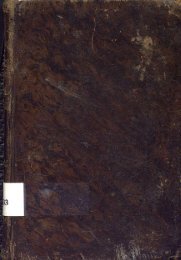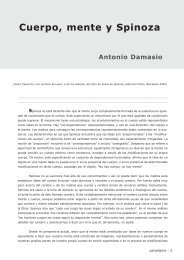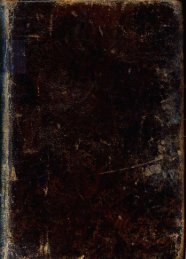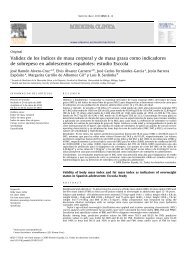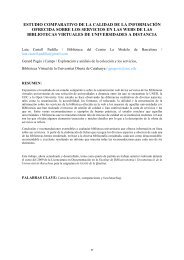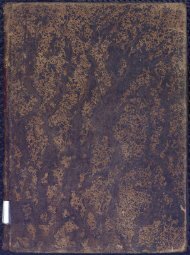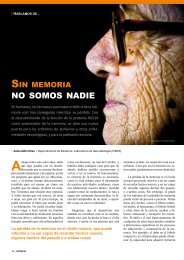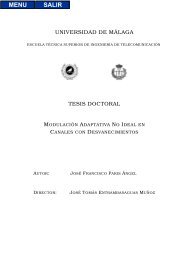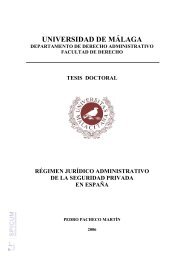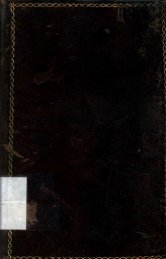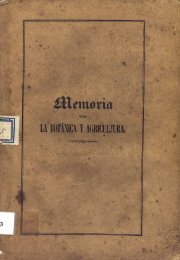Papel de las actividades superóxido dismutasa y catalasa en la ...
Papel de las actividades superóxido dismutasa y catalasa en la ...
Papel de las actividades superóxido dismutasa y catalasa en la ...
You also want an ePaper? Increase the reach of your titles
YUMPU automatically turns print PDFs into web optimized ePapers that Google loves.
RESULTS AND DISCUSSION<br />
great number of works point out the immunostimu<strong>la</strong>nt capacity of polysacchari<strong>de</strong>s in<br />
fish, increasing serum lysozyme, complem<strong>en</strong>t, cytotoxic or phagocytic activities<br />
(Santarém et al., 1997; Esteban et al., 2001; Chang et al., 2003; Bagni et al., 2005; Kumari<br />
and Sahoo, 2006).<br />
Results obtained after oral administration of pot<strong>en</strong>tial probiotic bacteria are<br />
inclu<strong>de</strong>d in article 2.3. (Article section). In this work, the respiratory burst activity was<br />
evaluated and, in or<strong>de</strong>r to <strong>de</strong>termine the protection <strong>de</strong>gree that probiotics could provi<strong>de</strong>,<br />
a chall<strong>en</strong>ge with P. damse<strong>la</strong>e subsp. piscicida was carried out. On the other hand,<br />
intestinal microbiota of fish fed with probiotics was studied in or<strong>de</strong>r to <strong>de</strong>tect possible<br />
changes due to feeding treatm<strong>en</strong>t.<br />
The selected bacterial strains, Pdp11 and Pdp13, iso<strong>la</strong>ted from gilthead seabream<br />
skin (Chabrillón, 2003), belong to Alteromonadaceae family, Shewanel<strong>la</strong> g<strong>en</strong>us.<br />
Although this is the first assay in vivo with strain Pdp13, several works have be<strong>en</strong><br />
carried out previously with strain Pdp11. Thus, Chabrillón et al. (2005a) studied<br />
interactions with the pathog<strong>en</strong> Vibrio harveyi, showing Pdp11 capacity to adhere to<br />
gilthead seabream intestinal mucus, the antagonist effect against a pathog<strong>en</strong>ic strain of<br />
V. harveyi, the capacity to inhibit the pathog<strong>en</strong> union and confer protection against an<br />
experim<strong>en</strong>tal infection. With regard to interactions betwe<strong>en</strong> strain Pdp11 and P.<br />
damse<strong>la</strong>e subsp. piscicida, Chabrillón et al. (2005b) <strong>de</strong>monstrated the antagonistic effect<br />
of Pdp11 against one strain of P. damse<strong>la</strong>e subsp. piscicida and the inhibition of the<br />
adhesion to intestinal mucus of this pathog<strong>en</strong>. These results lead the authors to consi<strong>de</strong>r<br />
the Pdp11 strain as a good candidate to be used as probiotic.<br />
In the pres<strong>en</strong>t work, it has be<strong>en</strong> observed that superoxi<strong>de</strong> anion production is<br />
significantly increased in fish fed with strain Pdp11 after two months from the<br />
beginning of the feeding trial, but fish fed with strain Pdp13 do not show modify<br />
phagocyte respiratory burst. However, fish fed with strain Pdp13 showed higher survival<br />
perc<strong>en</strong>tages after inocu<strong>la</strong>tion of the pathog<strong>en</strong> P. damse<strong>la</strong>e subsp. piscicida.<br />
Although there are numerous works in which respiratory burst activity induction<br />
by probiotics is <strong>de</strong>monstrated (Nikoske<strong>la</strong>in<strong>en</strong> et al., 2003; Gullian et al., 2004; Aubin et<br />
al., 2005; Brunt and Austin, 2005) the fact that pot<strong>en</strong>tial probiotic strain Pdp13 does not<br />
104



